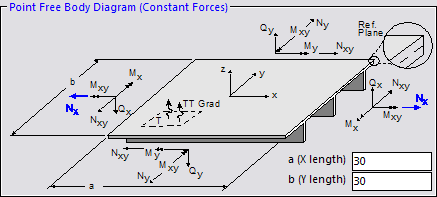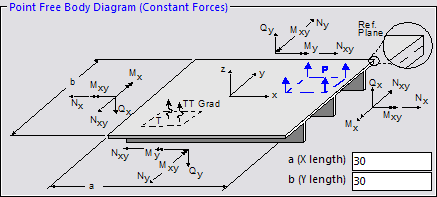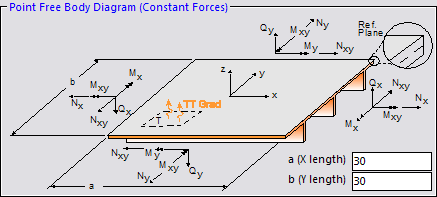
Shells must be oriented properly with respect to the HyperSizer convention. Failure to do so leads to invalid results. Users may define shell orientations in any manner. All necessary transformations are handled by the software internally. Imported shell orientations can be verified using the FEM Graphics. See Show FEM Directions/Edges
The HyperSizer shell orientation convention is illustrated in the Free Body tab of the Sizing form, shown below.

Tip: Always verify shell orientations using the FEM viewer. See Show FEM Directions/Edges.
The material x-axis (or 1-axis) defined by FEA solvers is equivalent to the HyperSizer x-axis. The HyperSizer x-axis defines the stiffener direction for stiffened panels and the "0" direction for laminates.
The normal vector direction determines which side of the shell the stiffeners are located on. This direction is denoted as the z-axis in the Point Free Body Diagram above. HyperSizer assumes that the element normal vectors always point “out” of the aeroshell and that the stiffeners are on the “underside” of the shell.
If the normal vectors are pointing in the wrong direction, then the element stiffnesses calculated by HyperSizer (which can be highly unsymmetric) will represent panels that are upside down. Element normal directions are typically determined by default depending on the ordering of the nodes defining each element. The element normal direction can be reversed using the FEM preprocessor.
Element Pressure
The element normal vectors also dictate the direction for surface pressure loading. Pressure is defined as positive if it acts in the same direction as the element normal (shown as the positive z-direction below) and negative if it acts in the direction opposite to the element normal vector.

Through-Thickness Temperature Gradient
The element normal vector also dictates the direction of the through-thickness temperature gradient. A positive through-thickness gradient is defined such that the temperature increases linearly (°F/inch) in the direction of the normal vector as shown below.

The figure below shows a typical example of how to model a stiffened panel in HyperSizer. The top portion of the figure shows the modeling intent. In this case, a Z stiffened cylindrical panel with the stiffeners on the interior of the shell is desired.
The bottom portion of the figure shows the realization of this model in HyperSizer. In order to model this stiffened panel configuration, a single plane of shell elements is meshed at the mid-plane of the top facesheet (no shell offsets). The element density is coarse and the element size is independent of the stiffener spacing. The material x-axis is aligned with the stiffener direction (orange arrows) and the element normal directions are pointing away from the stiffeners (blue arrows).

For discrete modeling techniques, the shell element normal vectors should point "out" of the aeroshell (same as smeared panels).


